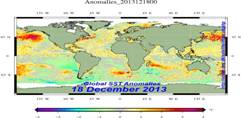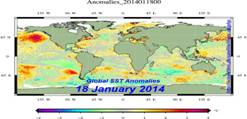Home
|
About
the Role of North- and Baltic Sea during
Winter 2013/14 and
human impact!
Started on 03
January 2014, and will be continued.
1st Part (03
Jan.2014)
;
Part 2 (06. Jan. 2014)
Part
3 (12. Jan.2014),
Part
5 (30. Jan.14), Part
6 (9.Feb.14)
; Part 7 (22.Feb.14)
Part
4:
Europe
has spring condition in January 2014,
and Met. Services have no clue!
Posted: 20/21. January 2014 (11d);
a.
Introduction
December was too warm. January as per today was too warm. Is only the
Atlantic responsible? What role did well above average sea surface
temperature (SST) play since early December 2013 in all regional sea areas
from English Channel to
Finnish
Gulf
?

|

|

|

|
Fig. 1, 13 December 2013
|
Fig. 2, 30 December 2013
|
Fig. 3; 09 January 2014
|
Fig. 4,
20 January 2014
|
At least meteorological
services do not care. In case January
remains as mild as per 17/01, it would become the third mildest in
Germany
since 1881, claims DWD (Deutscher
Wetterdienst, Press-release, 17. Jan.14), suggesting that it is a matter of the Jet stream, which separate
cold polar air from warmer subtropical air. However the Atlantic weather machine has
supremacy only as long as cold continental air is held at bay. At Met
Newsblog (16 Jan.14) titled: “Mild wet winter continues in early
January figures”, not one word about this, but saying –inter
alias-:
·
Provisional
half-month statistics up to the 15th of January show a
continuation of the generally mild and wet theme of the
UK
’s winter thus far. The mean
UK
temperature up to the 15th of January is 5.1 °C, which is 1.5
°C above the long-term (1981-2010) average.
·
The
mild January so far follows on from a mild UK December, which had a mean
temperature of 5.7 °C, which is 1.8 °C above the long-term average –
making it the eighth mildest December in records dating back to 1910, and
the mildest since 1988….(cont)
·
The
wet January so far once again follows the theme set in December, which saw
184.7mm of rain – which is 154% of the average for the month.
….(cont)
·
The
main reason for the mild and wet weather so far is that we have seen a
predominance of west and south-west winds, bringing in mild air from the
Atlantic – as well as generally unsettled conditions. …. (cont.)
The
DWD is not more explicit, just
observing that it has been unusual mild until now, and that mild air form
the Atlantic have moved up to the Ural. That regional seas west of the
Ural may act as a significant source to ‘allow’ Atlantic low pressure
to move straight eastwards and reach the Ural, and are due to cold air
from NE stopped from entering West Europe, and diverted either the North
Cape or Gibraltar, seems not of great interest for forecaster and weather
analysts.
b.
Global Overview
Since
mid December the snow cover across the Northern Hemisphere has hardly
changed (Fig 5 & 6).
|

|

|
|
Fig. 5, 18. December 2013
|
Fig. 6, 19. January 2014
|
Remarkable are the high SST anomalies in the Northern Pacific. AT
the same time deviation in the
North Atlantic
are modest (Fig. 7 & 8)
|

|

|
|
Fig. 7, 18.
December 2013
|
Fig. 8, 18.
January 2014
|
One air temperature anomaly DWD graphic of current winter 2013/14 is
given in Fin 9, and concerning SST anomalies the
Arctic
in Fig.10, both per 17. January 2014.
|

|

|
|
Fig. 9, published 17. Jan. 2014
|
Fig. 10, per 17. Jan. 2014
|
The high temperature anomaly in Europe (Fig. 9) and SST in Europe,
particularly Barents Sea, and
Northern Europe
(Fig. 1-4) is remarkable. What role did shipping, and off-shore platforms
and wind farms play? The high
heat figures indicate that they significantly contributed to hold cold air
from the Arctic and
Eastern Russia
at bay.
The
high temperature anomaly in Europe (Fig. 9) and SST in Europe,
particularly Barents Sea, and
Northern Europe
(Fig. 1-4) is remarkable. What role did shipping, and off-shore platforms
and wind farms play? The high
temperature figures indicate that they significantly contributed to hold
cold air from the Arctic and
Eastern Russia
at bay.
c.
Russia
and
Europe
The
recent temperature situation in
Russia
is shown in Fig. 11 & 12, which have now reached the Baltic countries,
which experience temperatures below of minus 15°C over the last few days,
while the Western Baltic Sea were still above 0°C.
|

|

|
|
Fig, 11, T°C, 06 January 2014
|
Fig. 12; T°C, 21 January 2014
|
Until now heating capacity of the
Baltic Sea
remained very high, preventing sea ice forming (Fig. 12-16). Only now the
situation tends toward ‘normal’ in the NE of the Baltic Fig. 17+18.
However, from the Baltic proper to the English Channel SST are still well
above average (Fig. 4). Remains the question: Why is this the case?
|
Recent
Ice Conditions – Fig. 13,15, 17
|
Average
- Fig. 14, 16, 18
|
|

|

|
|

|

|
|

|

|
Provisonal : Global SST-Anonmalies 29 Jan. 2014 // NOTE: High
devation in NE Pacific!

Part
1: (03
Jan.2014)
Mild
December 2013 caused by off-shore wind farms and human activities in
North- and
Baltic Sea
?
Will winter 2013/14 show an anthropogenic impact?
03 January 2014 (seatraining2007_1412a)
Part
2: (06 Jan. 2014)
Part
2: North Atlantic dominated December 2014 weather in
Europe
.
Continental Asian cold was hold at bay.
Part
3: (08 January 2014
Part
3: What will bring winter to
Europe
?
Posted 08 January 2013 (2007seatraing.de; 1412c)
+
Add 1 (12.Jan.2014) Flooding in UK
To
be continued
Home
|
|


